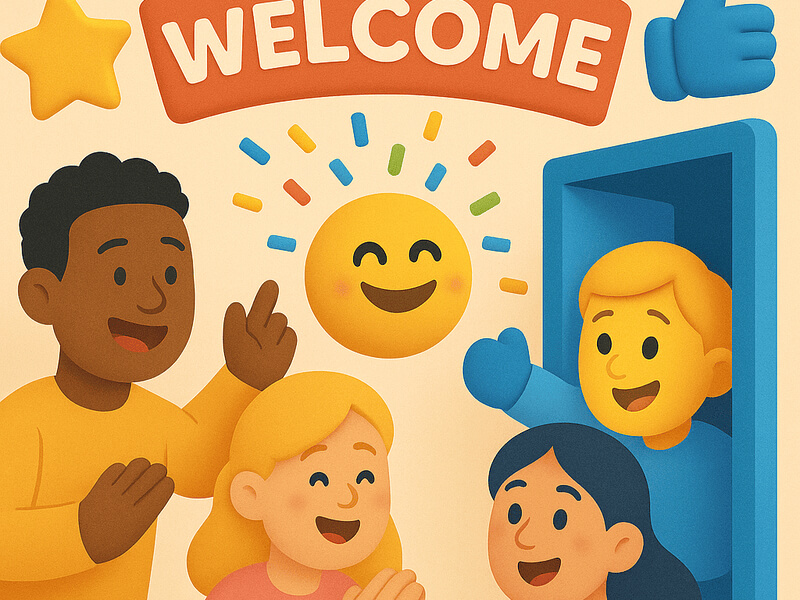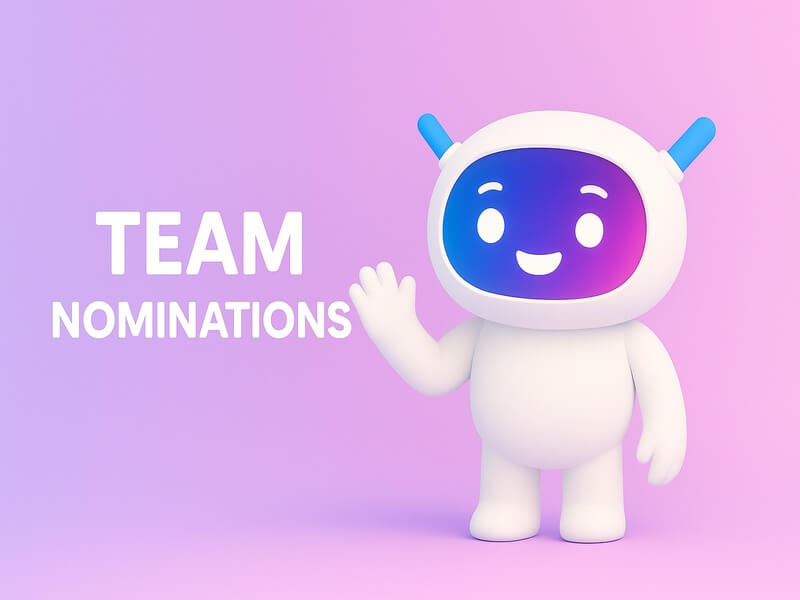
Creating compelling team nomination examples requires more than recognizing that collaborative work deserves acknowledgment - it demands understanding how to document group achievements effectively and present them in ways that evaluation committees find meaningful. Many organizations struggle with transitioning from individual-focused recognition to celebrating the collective efforts that drive exceptional business outcomes. At Matter, we understand the challenges leaders face when trying to capture collaborative excellence through structured nomination processes while ensuring fairness and inspiring continued teamwork. The complexity multiplies when teams achieve remarkable results but lack clear frameworks for documenting these achievements in nominations that truly reflect their collaborative impact.
This comprehensive guide provides 37+ detailed team nomination examples across various categories, industries, and recognition scenarios to help you master the art of group recognition. You'll discover specific examples for project completion teams, team leaders, individual contributors within collaborative environments, and long-term excellence recognition programs. The guide includes industry-specific nomination examples for healthcare, technology, and sales teams, along with practical templates and forms that streamline the nomination process. Whether you're launching your first team recognition program or enhancing existing efforts through team incentive strategies, these examples will help you create nominations that celebrate collaborative achievements while inspiring continued excellence throughout your organization.
What are team nominations, and how do they work
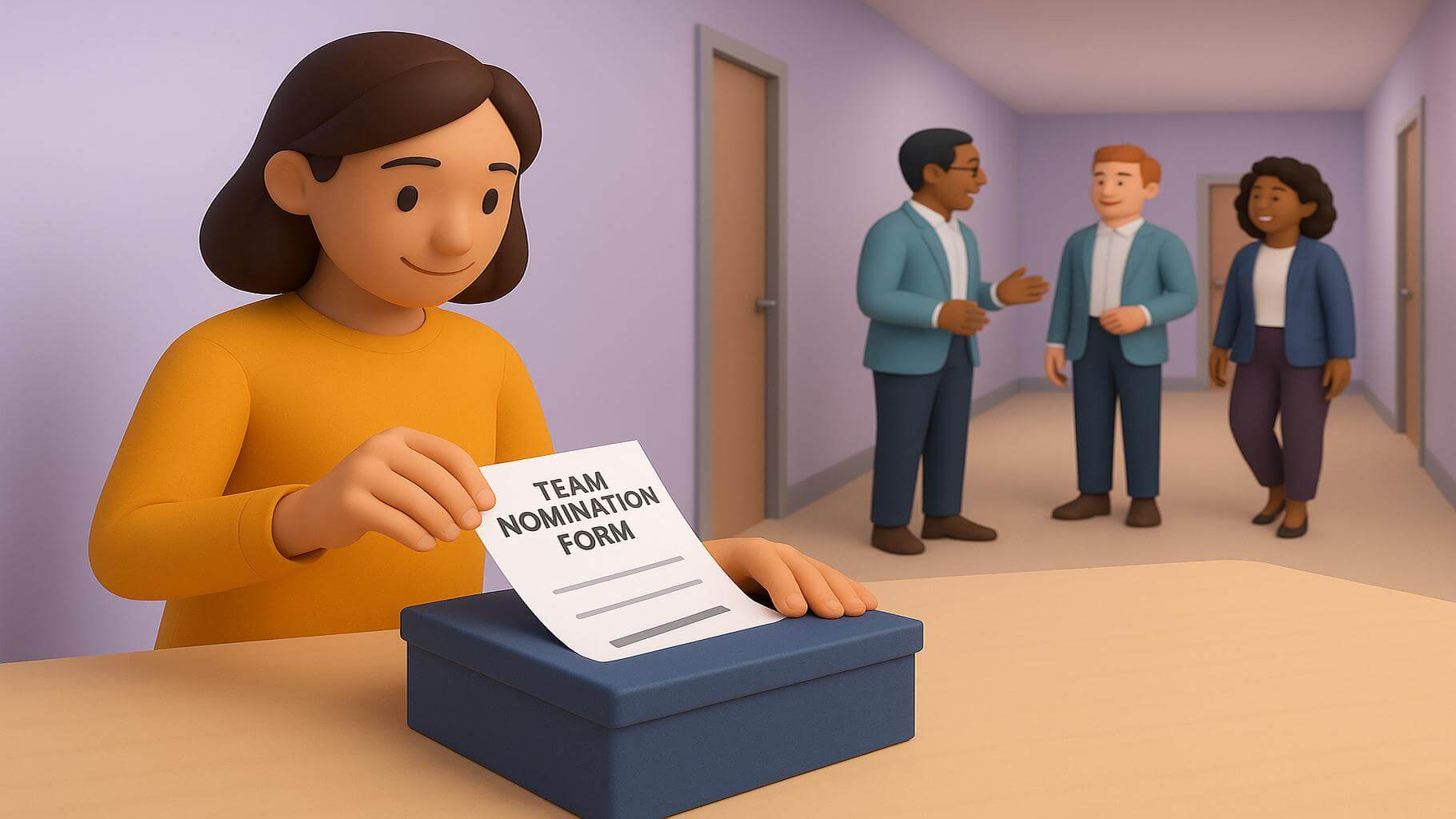
Team nominations represent a structured approach to recognizing group achievements within organizational recognition programs. Unlike individual acknowledgments that focus on single employees, team nominations celebrate collective efforts, shared accomplishments, and collaborative excellence that emerges when multiple team members work together toward common goals. The nomination process typically involves identifying specific groups, documenting their achievements with detailed supporting evidence, and submitting formal proposals for consideration by recognition committees or leadership teams.
Understanding team nomination processes in workplace recognition
The nomination process for teams involves several key steps that ensure fair evaluation and comprehensive documentation. Initially, nominators identify groups whose collaborative efforts merit recognition, whether entire departments, cross-functional project teams, or informal working groups that achieved exceptional results. The nominator serves as an advocate, gathering specific details about the team's accomplishments, documenting measurable outcomes, and preparing written submissions that highlight how the group exceeded expectations or demonstrated excellence in their collaborative efforts. These systematic approaches often integrate with broader employee rewards system frameworks that support comprehensive recognition programs across the organization.
Committee members typically evaluate submissions based on predetermined criteria, including innovation, impact on organizational goals, demonstration of company values, and evidence of exceptional teamwork. The evaluation process requires careful consideration of how team members supported each other, overcame challenges together, and achieved results that individual efforts alone could not have accomplished. Recognition committees often request additional details about the nominee's position within the group dynamic and how each member contributed to overall success. Organizations can reference employee nomination sample formats to ensure comprehensive documentation that supports fair evaluation processes.
Administrative support plays a crucial role in efficiently managing the nomination process. Staff members help coordinate submission deadlines, maintain organized records of all proposals, and ensure that evaluation committees receive complete information for making informed decisions. The system requires ongoing management to track submissions, communicate with nominators about missing details, and coordinate recognition events where awarded teams receive acknowledgment for their collaborative achievements.
Differences between team nominations and employee of the month nomination examples
Team nominations differ significantly from individual recognition programs in scope, criteria, and evaluation methods. While employee of the month nomination examples typically focus on individual performance, personal achievements, and specific tasks completed by single employees, team nominations emphasize collective impact, shared responsibility, and collaborative problem-solving. The writing approach for team submissions requires describing group dynamics, explaining how team members supported one another, and demonstrating how collective efforts achieved results that exceeded what individuals could accomplish independently.
Individual nominations often highlight personal initiative, leadership qualities, and specific job-related accomplishments. Team nominations require a broader perspective, documenting how multiple team members contributed unique skills, maintained a positive attitude throughout challenges, and demonstrated excellent communication while working toward shared goals. The evaluation criteria shift from assessing individual merit to understanding group effectiveness, measuring collective impact, and recognizing collaborative excellence that emerges from successful teamwork through structured nomination processes. Organizations can adapt existing employee of the month nomination template formats to create comprehensive frameworks for team recognition programs.
The documentation requirements also differ substantially between individual and team recognition programs. Team nominations demand more complex writing that captures multiple perspectives, describes various roles within the group, and explains how different team members complement each other's strengths. Nominators must provide specific details about group processes, explain how the team managed complex challenges, and demonstrate how collective efforts resulted in exceptional outcomes that warrant recognition and celebration.
How nomination form templates work for group recognition
Nomination form templates for team recognition provide structured frameworks that guide nominators through comprehensive documentation processes. These templates typically include sections for identifying information about the team, describing the group's composition and purpose, documenting specific achievements with measurable outcomes, and explaining how the team's efforts align with organizational values and expectations. Well-designed forms help nominators organize their thoughts, ensure all necessary details are included, and present compelling cases for recognition consideration.
The forms often request specific information about each team member's role, contribution to group success, and demonstration of collaborative excellence. Nominators describe how team members worked together, supported each other during challenging periods, and maintained focus on shared objectives despite obstacles or competing priorities. The template structure helps ensure consistency across submissions while allowing flexibility for describing unique group dynamics and special circumstances that made the team's achievements exceptional.
Administrative staff use these standardized forms to streamline the evaluation process, ensuring that committees receive consistent information in a format that facilitates fair comparison between different team nominations. The templates help reduce processing time, minimize confusion about required information, and improve the overall quality of submissions by prompting nominators to include relevant details that support their recognition proposals. Faculty members and directors often provide input on template design to ensure that forms capture the most relevant information for making informed recognition decisions.
Why team nomination examples are important for group recognition
Team nomination examples serve as powerful tools for creating recognition-rich cultures that value collaborative excellence alongside individual achievement. When organizations implement comprehensive team recognition programs, they send clear messages about the importance of cooperation, shared accountability, and collective problem-solving. Well-crafted nominations help employees understand what collaborative behaviors merit recognition, provide models for describing group achievements effectively, and demonstrate organizational commitment to celebrating teamwork as a core value that drives business success. These programs often incorporate broader employee recognition ideas that reinforce collaborative values throughout the organization.
Building a collaborative culture through team nomination examples
Effective team nomination examples help establish cultural norms that prioritize collaboration, mutual support, and shared success within organizational environments. When employees regularly see examples of teams being recognized for working together effectively, they begin to understand that individual excellence alone may not be sufficient for advancement or recognition. The nomination process encourages team members to pay attention to group dynamics, actively support their colleagues, and focus on collective outcomes rather than personal achievement.
These examples also provide concrete illustrations of what excellent teamwork looks like in practice. New employees can review past nominations to understand expectations for collaboration, learn about successful team strategies, and identify behaviors that contribute to group effectiveness. The detailed descriptions in team nominations serve as informal training materials, helping staff members develop better collaboration skills and understand how their individual contributions fit within larger team objectives and organizational goals.
Regular team recognition creates positive reinforcement cycles that encourage continued collaborative behavior throughout the organization. When teams receive acknowledgment for working together effectively, other groups become motivated to improve their own collaborative processes, seek opportunities to support colleagues, and focus on achieving shared objectives. This cultural shift typically results in improved employee satisfaction, enhanced project outcomes, and stronger organizational performance across multiple departments and functional areas through comprehensive employee rewards programs.
Creating fair recognition for group achievements and contributions
Fair team recognition requires systematic approaches that acknowledge all contributing team members while highlighting collective achievements that warrant celebration. Effective nomination examples demonstrate how to document group contributions without favoring particular individuals, ensure that all team members receive appropriate credit for their participation, and emphasize outcomes that resulted from collaborative efforts rather than individual excellence. This balanced approach helps prevent recognition programs from inadvertently creating competition between team members or overlooking valuable contributors.
The nomination process must account for different types of contributions within teams, recognizing that team members may contribute through various means, including technical expertise, project management, creative problem-solving, or providing essential support services. Well-written nominations describe how diverse skills and perspectives combined to create successful outcomes, explaining how each team member's unique contributions enhanced overall group effectiveness and helped achieve exceptional results that merit organizational recognition through meaningful employee rewards.
Evaluation committees need clear criteria for assessing team achievements fairly across different departments, project types, and organizational levels. Effective nomination examples guide the documentation of measurable outcomes, describe collaborative processes, and explain how team achievements align with organizational priorities and values. This systematic approach ensures that recognition decisions reflect genuine merit while maintaining consistency and transparency throughout the evaluation process.
Inspiring teamwork through structured team award nomination examples
Structured team award nomination examples provide blueprints for effective collaboration by documenting successful team strategies, highlighting innovative problem-solving approaches, and demonstrating how groups can overcome significant challenges through coordinated efforts. These examples serve as inspiration for other teams, providing practical guidance on improving collaborative effectiveness. When employees review detailed descriptions of award-winning teams, they gain insights into effective communication strategies, conflict resolution approaches, and methods for maintaining group cohesion during difficult projects through comprehensive employee recognition.
The nomination examples also help establish benchmarks for team excellence that other groups can strive to achieve. By documenting specific behaviors, processes, and outcomes that led to recognition, these examples create roadmaps for team development and provide concrete goals for collaborative improvement. Teams can use award-winning examples as models for structuring their own collaborative efforts, identifying areas for improvement, and developing strategies for achieving exceptional group performance.
Recognition through structured award programs fosters positive competition among teams while reinforcing organizational values related to collaboration and shared success. When teams see detailed examples of recognized achievements, they become motivated to enhance their own collaborative processes, seek innovative solutions to challenges, and maintain high standards for group performance. This competitive dynamic typically leads to organizational improvements in project management, employee engagement, and overall business performance across multiple departments and operational areas through strategic employee incentive programs.
8+ team nomination examples for project completion and collaboration
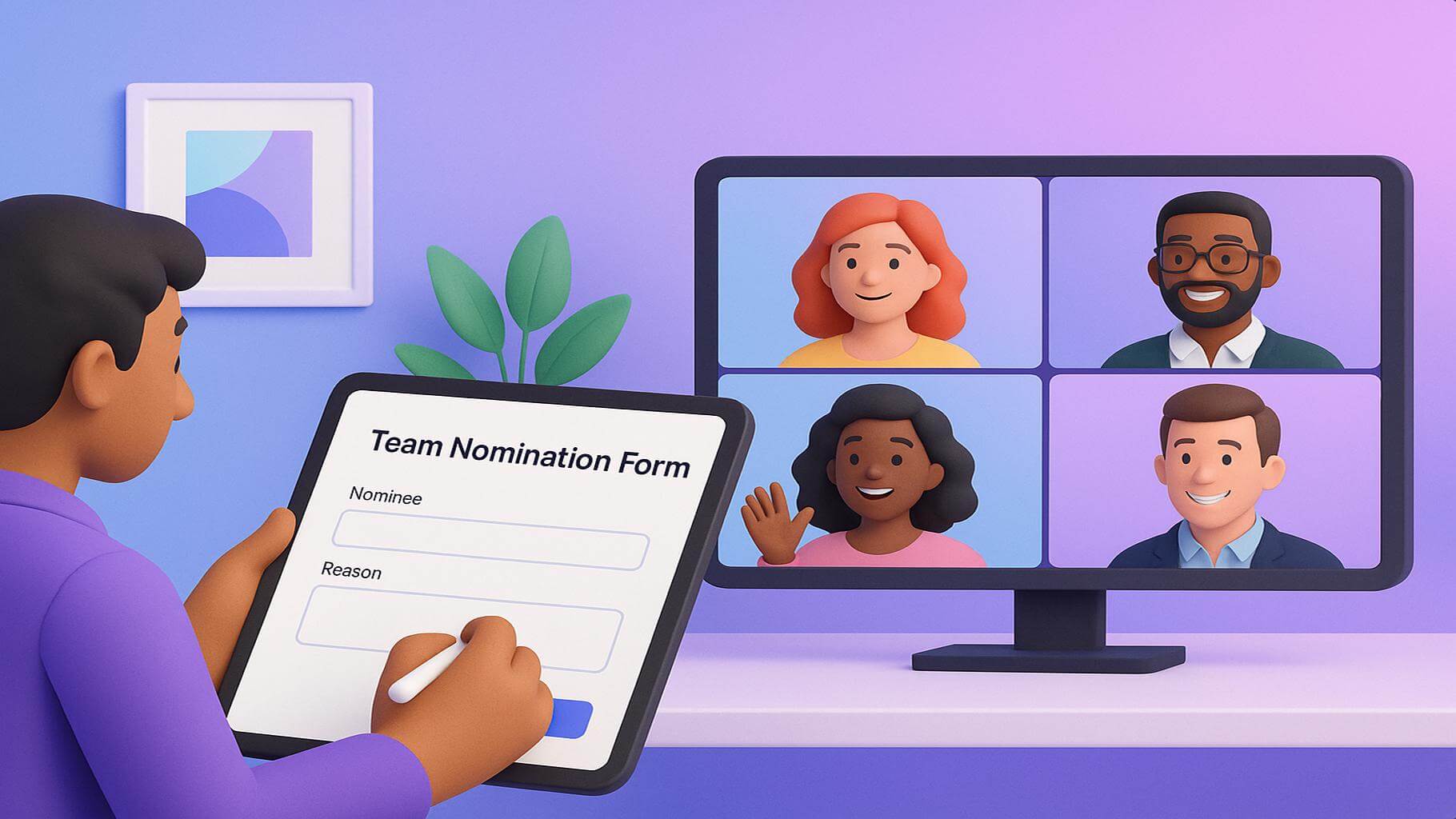
Project completion teams often demonstrate exceptional collaboration skills while managing complex initiatives, coordinating multiple stakeholders, and delivering results under challenging circumstances. Effective project team nominations highlight specific collaborative achievements, document innovative problem-solving approaches, and demonstrate how group efforts exceeded expectations or delivered exceptional value to the organization. These examples typically focus on teams that successfully navigated obstacles, implemented creative solutions, or achieved remarkable outcomes through coordinated teamwork and shared commitment to project success. Organizations often enhance these recognition efforts through team incentive programs that celebrate collaborative excellence and motivate continued high performance.
Cross-departmental project team nomination examples
Example 1: Multi-Department Software Implementation Team
This cross-departmental team demonstrated exceptional collaboration during the implementation of a complex system, which required coordination among the information technology, human resources, finance, and operations departments. Team members from each department worked together for six months, maintaining excellent communication throughout the project despite competing priorities and tight deadlines. The group developed innovative training processes that ensured smooth transitions for all employees while meeting implementation deadlines ahead of schedule. The nominee serves as the technical lead, coordinating efforts across all departments while maintaining a positive attitude during challenging phases.
Example 2: Product Launch Coordination Team
A cross-functional product launch team brought together employees from marketing, sales, engineering, and customer service departments to coordinate a major product release. The team demonstrated remarkable initiative in developing comprehensive launch strategies, creating detailed communication plans, and implementing quality assurance processes that exceeded industry standards. Team members maintained a positive attitude throughout the challenging timeline, managing complex logistics and ensuring a successful market entry. The team efficiently completed all tasks while meeting strict deadlines.
Example 3: Facility Relocation Project Team
This interdepartmental team coordinated a major office relocation involving over 200 employees across multiple departments. The group demonstrated excellent ideas for minimizing business disruption, developed efficient processes for managing logistics, and maintained excellent communication with all stakeholders throughout the transition. Team members from facilities, human resources, information technology, and administrative departments worked together to complete the relocation ahead of schedule and under budget while ensuring minimal disruption to daily operations.
Innovation and problem-solving team award nomination examples
Example 4: Process Improvement Innovation Team
A volunteer innovation team identified significant inefficiencies in existing operational processes and developed creative solutions that improved organizational efficiency by implementing new workflows. The team demonstrated exceptional commitment to continuous improvement, spending additional time analyzing current systems and proposing innovative alternatives. Team members collaborated effectively to test new approaches, gather feedback from multiple departments, and implement sustainable improvements that benefited the entire organization while maintaining operational excellence.
Example 5: Customer Solution Development Team
This problem-solving team responded to complex customer challenges by developing innovative service delivery approaches that exceeded client expectations while providing excellent customer service. The group demonstrated remarkable dedication to understanding client needs, developing customized solutions, and maintaining ongoing communication throughout the project. Team members from customer service, technical support, and account management departments worked together to identify root causes and implement comprehensive solutions that strengthened client relationships.
Example 6: Technology Innovation Project Team
A technology-focused innovation team developed creative solutions for modernizing legacy systems while maintaining operational continuity. The group demonstrated exceptional technical expertise combined with excellent project management skills, successfully implementing complex system upgrades without disrupting daily operations. Team members collaborated effectively to test new technologies, train other employees, and ensure smooth transitions that enhanced organizational capabilities and improved efficiency across multiple departments.
Crisis response and emergency team nomination examples
Example 7: Emergency Response Coordination Team
During an unexpected facility emergency, this cross-departmental response team demonstrated exceptional coordination and leadership in high-pressure situations. The group maintained excellent communication with all stakeholders throughout the crisis. They implemented emergency procedures efficiently while ensuring employee safety and minimizing business disruption. Team members from safety, facilities, human resources, and operations departments worked together seamlessly to manage the crisis. The team coordinated recovery efforts that exceeded organizational expectations. Throughout the entire process, they maintained unwavering focus on employee welfare.
Example 8: Business Continuity Planning Team
This emergency preparedness team developed comprehensive business continuity plans that proved essential during an unexpected operational disruption. The group demonstrated remarkable foresight in identifying potential risks, developing mitigation strategies, and creating detailed response procedures. Team members collaborated effectively to test emergency protocols, train other employees, and ensure organizational readiness for various contingency scenarios that could impact business operations and employee safety.
6+ team leader nomination examples for management and guidance
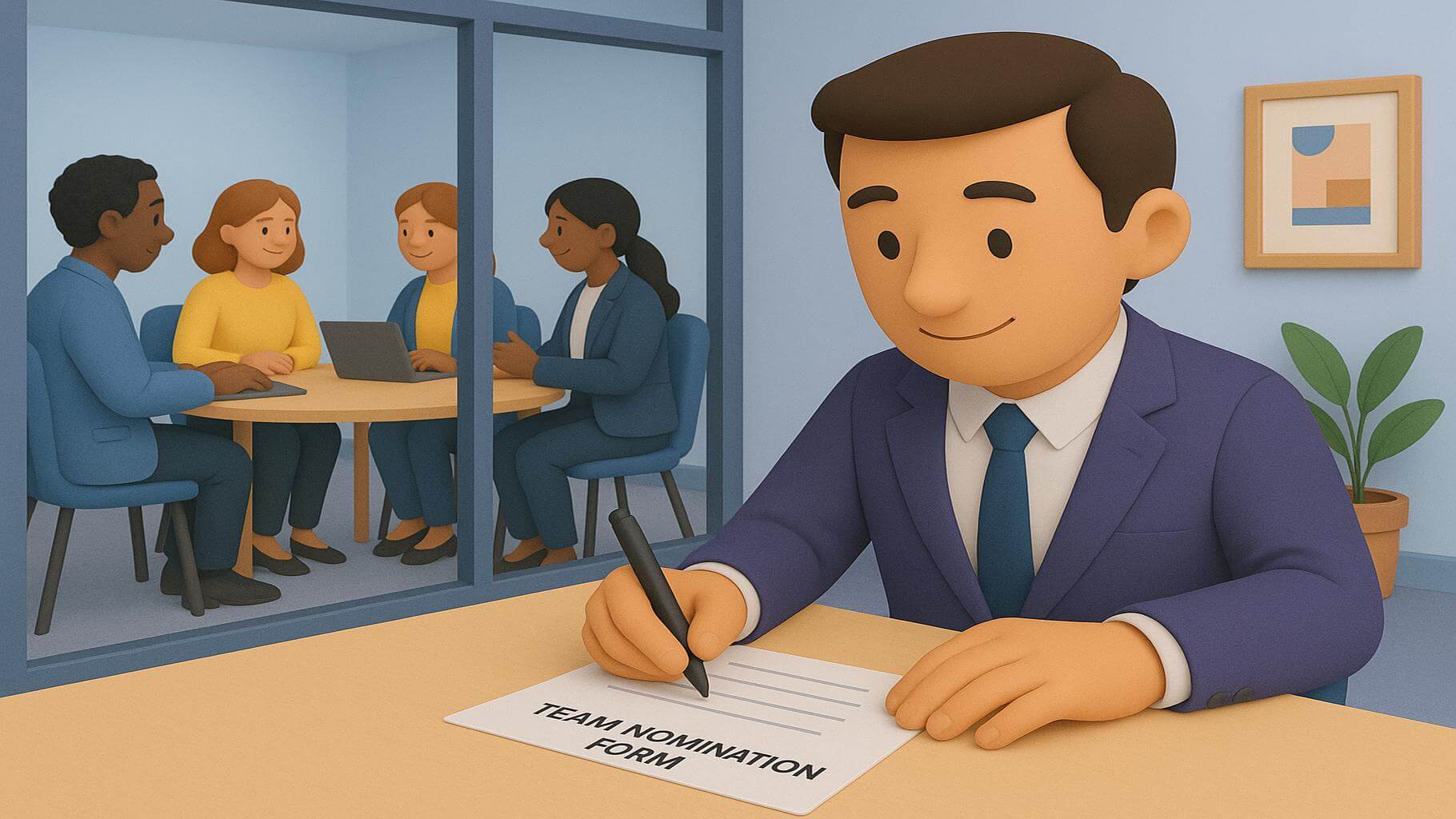
Team leaders who guide groups toward exceptional achievements often demonstrate unique combinations of management skills, collaborative leadership, and commitment to team member development. Effective team leader nominations highlight specific leadership behaviors that enhanced group performance, document innovative management approaches, and demonstrate how leadership support contributed to exceptional team outcomes through effective nomination letter samples. These nominations typically focus on leaders who empowered team members, facilitated effective collaboration, and created environments where groups could achieve remarkable results through coordinated efforts.
Supervisory excellence team leader nomination examples
Example 9: Department Operations Team Leader
This team leader consistently demonstrated supervisory excellence by managing a 15-member department through a period of significant organizational change. She developed innovative approaches to maintaining team morale while implementing new processes and managing increased workload demands. The leader maintained excellent communication with all team members, provided clear guidance during uncertain periods, and ensured that the department continued to meet all performance expectations while supporting individual employee development. Her nominee position involved coordinating daily operations while managing complex stakeholder relationships.
Example 10: Project Management Team Leader
A project management team leader guided multiple concurrent initiatives involving employees from different departments while maintaining exceptional standards for project delivery and team collaboration. She demonstrated excellent ideas for coordinating complex schedules, managing competing priorities, and ensuring that all team members received appropriate support and recognition for their contributions. The leader's commitment to team success resulted in consistently meeting project deadlines while maintaining high-quality standards and positive team dynamics throughout the organization.
Mentoring and development team leader nomination examples
Example 11: Professional Development Team Leader
This team leader created comprehensive mentoring programs that significantly enhanced team member capabilities and career development opportunities. She demonstrated exceptional commitment to employee growth by developing individualized training plans for each team member. The leader facilitated skill-building opportunities and provided ongoing support for professional advancement. Her efforts resulted in measurable improvements in team performance and increased employee satisfaction. The department also experienced enhanced retention rates while maintaining operational excellence. Throughout all initiatives, she consistently supported broader organizational goals.
Example 12: Cross-Training Initiative Team Leader
A team leader implemented innovative cross-training programs that improved team flexibility and enhanced individual employee skills across multiple functional areas. She demonstrated excellent leadership by identifying development opportunities, creating structured learning experiences, and ensuring that all team members received equal access to skill enhancement opportunities. The leader's initiative led to improved team resilience, enhanced operational efficiency, and increased employee engagement throughout the department, while maintaining productivity standards.
Change management team leader nomination examples
Example 13: Organizational Transition Team Leader
During a major organizational restructuring, this team leader demonstrated exceptional change management skills by guiding employees through transition processes while maintaining team productivity and morale. She developed comprehensive communication strategies, provided clear guidance about new expectations, and ensured that all team members received appropriate support during the adjustment period. The leader's efforts resulted in smooth transitions with minimal disruption to operations, maintaining positive team dynamics throughout the change process.
Example 14: Technology Implementation Team Leader
A team leader successfully managed the implementation of new technology systems across multiple departments while ensuring minimal disruption to daily operations. She demonstrated excellent project management skills by coordinating training programs, managing implementation timelines, and providing ongoing support to employees as they adapted to new systems. The leader's commitment to team success led to faster adoption rates, improved user satisfaction, and enhanced operational efficiency following the system implementation.
Team member nomination examples for individual contributions within groups
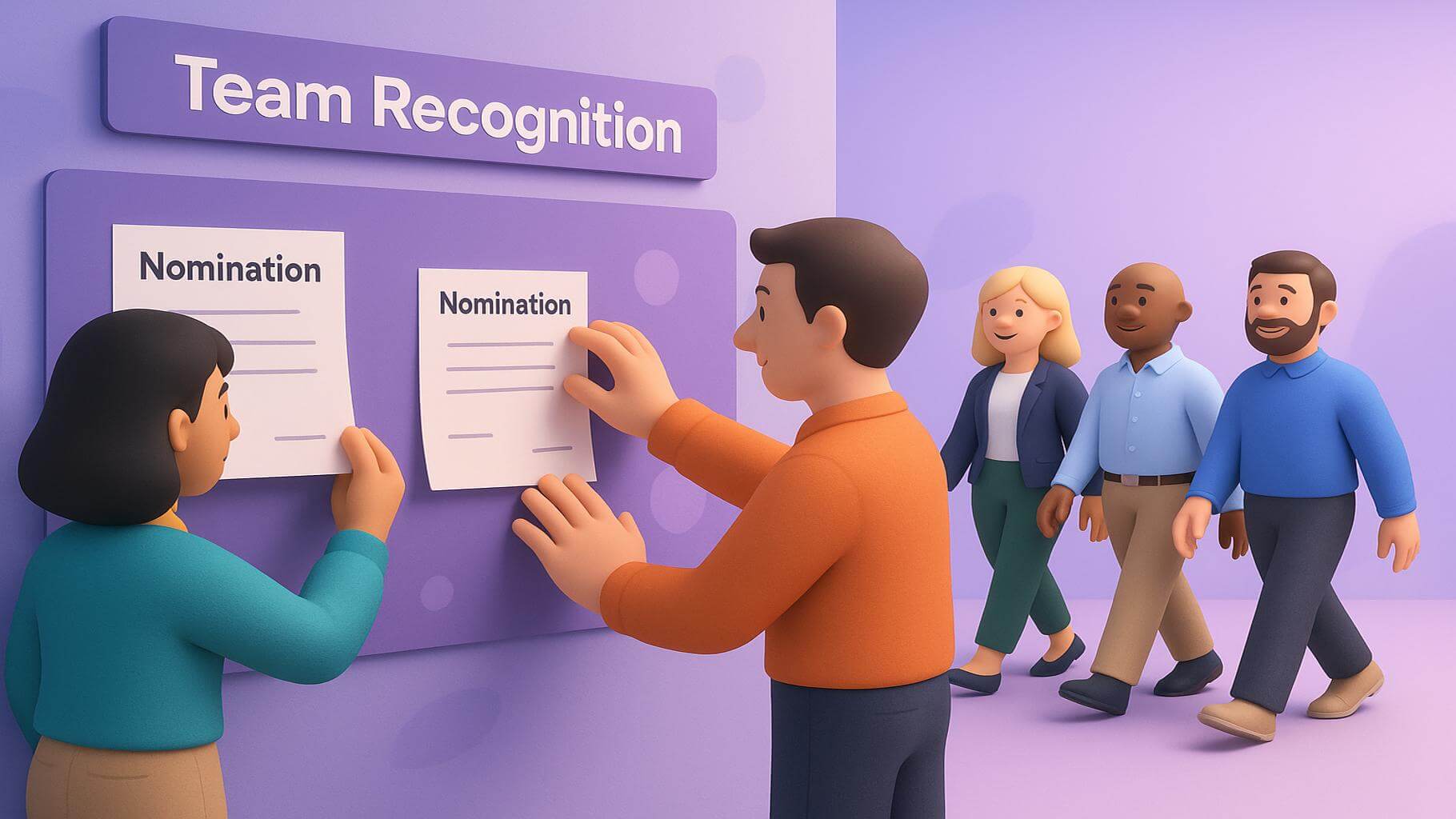
Individual team members often make exceptional contributions that enhance the overall group effectiveness, demonstrating collaborative excellence and a commitment to shared success. Effective team member nominations highlight specific individual behaviors that strengthened team performance, document unique contributions that supported group objectives, and demonstrate how individual excellence enhanced collective outcomes through peer nomination processes. These nominations recognize employees who consistently support colleagues, contribute innovative ideas, and maintain a positive attitude while working toward shared goals within collaborative environments.
Supportive collaboration team member nomination examples
Example 15: Cross-Functional Support Team Member
This team member consistently provided exceptional support to colleagues across multiple departments while maintaining excellence in individual responsibilities and contributing to overall team success. She demonstrated remarkable initiative in identifying opportunities to assist other team members, generously sharing her expertise, and maintaining positive workplace relationships that enhanced group collaboration. The nominee's efforts resulted in improved team efficiency, enhanced knowledge sharing, and stronger collaborative relationships throughout the organization while maintaining individual productivity standards.
Example 16: Project Coordination Support Team Member
A team member provided invaluable coordination support during complex project implementations by managing communication between different departments and ensuring that all stakeholders received timely updates. She demonstrated excellent organizational skills, maintaining detailed project documentation, facilitating effective meetings, and ensuring that team members had access to the necessary resources for successful project completion. The nominee's contributions significantly enhanced project outcomes and improved collaborative effectiveness across multiple teams and departments.
Knowledge sharing team member nomination examples
Example 17: Technical Expertise Sharing Team Member
This team member demonstrated exceptional commitment to knowledge sharing by developing comprehensive training materials and providing ongoing technical support to colleagues throughout the organization. She created detailed documentation, conducted informal training sessions, and maintained open availability for questions from other employees seeking to enhance their technical capabilities. The nominee's efforts resulted in improved technical competency across multiple departments and enhanced overall organizational capability for managing complex technical challenges while maintaining service quality.
Example 18: Best Practices Documentation Team Member
A team member took the initiative to document and share best practices across different departments, creating valuable resources that improved operational efficiency and enhanced collaborative effectiveness. She demonstrated excellent writing skills while developing comprehensive procedures, creating training materials, and ensuring that all employees had access to current information about effective work processes. The nominee's contributions resulted in reduced training time for new employees and improved consistency in operational approaches throughout the organization.
Conflict resolution team member nomination examples
Example 19: Workplace Mediation Team Member
This team member consistently demonstrated exceptional skills in resolving workplace conflicts while maintaining positive relationships with all parties involved and contributing to overall team harmony. She approached conflicts with professionalism, facilitated productive discussions between parties with differing views, and helped develop mutually acceptable solutions that strengthened team cohesion. The nominee's efforts led to improved workplace relationships, reduced tension between departments, and enhanced collaborative effectiveness throughout the organization, while maintaining professional standards.
Example 20: Communication Enhancement Team Member
A team member identified communication challenges within the team and developed innovative solutions that improved information sharing and reduced misunderstandings between colleagues. She demonstrated excellent interpersonal skills while facilitating better communication processes, creating structured meeting formats, and ensuring that all team members felt heard and valued. The nominee's contributions resulted in improved team dynamics, enhanced project coordination, and stronger collaborative relationships across multiple departments and functional areas.
Team of the year nomination examples for long-term excellence
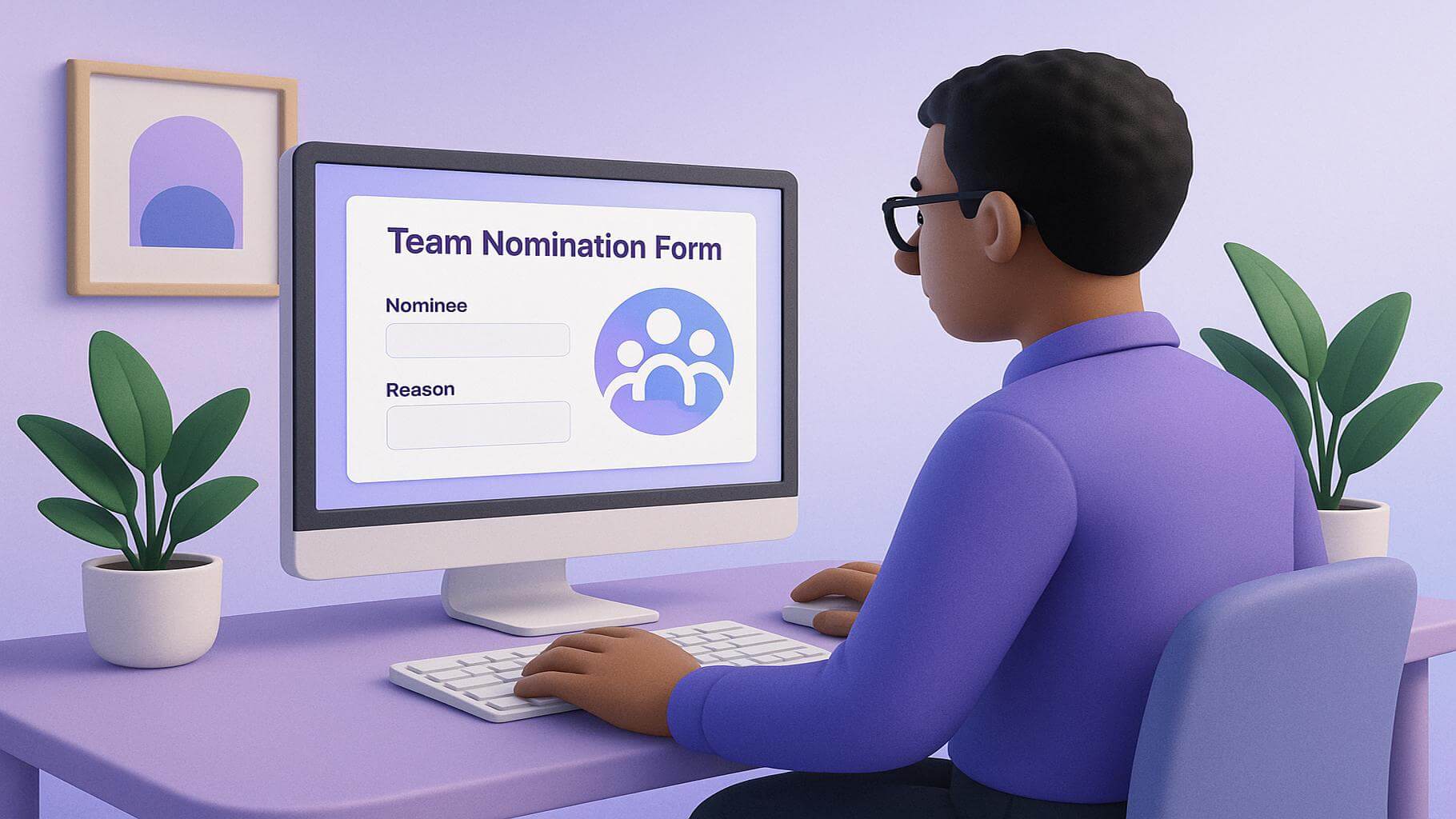
Teams that achieve sustained excellence over extended periods demonstrate exceptional collaborative consistency, ongoing commitment to shared objectives, and remarkable ability to maintain high performance standards while adapting to changing organizational needs. Effective team of the year nominations document long-term achievements, highlight consistent collaborative excellence, and demonstrate how teams maintained exceptional performance while contributing significantly to organizational success through comprehensive team rewards. These nominations typically focus on teams that achieved measurable improvements, demonstrated continuous innovation, and maintained positive team dynamics throughout challenging periods.
Annual achievement team of the year nomination examples
Example 21: Customer Service Excellence Team
This customer service team maintained exceptional performance standards throughout the year while consistently exceeding customer satisfaction targets and demonstrating remarkable commitment to excellent customer service delivery. The team developed innovative approaches to addressing customer concerns, implemented efficient processes for managing service requests, and maintained a positive attitude during high-demand periods. Team members collaborated effectively to share knowledge, support colleagues during challenging situations, and ensure consistent service quality that exceeded organizational expectations and industry standards while maintaining operational efficiency.
Example 22: Sales Performance Leadership Team
A sales team achieved outstanding results throughout the year by implementing collaborative approaches that enhanced individual performance while strengthening overall team effectiveness. The group demonstrated exceptional commitment to shared success by developing comprehensive training programs, implementing effective lead-sharing strategies, and maintaining supportive relationships that enhanced both individual and collective achievements. Team members consistently supported one another, shared successful strategies, and maintained focus on both individual and team objectives throughout challenging market conditions.
Sustained performance team of the year nomination examples
Example 23: Operations Efficiency Excellence Team
This operations team maintained exceptional efficiency standards throughout the year while implementing continuous improvement initiatives that enhanced organizational productivity and operational effectiveness. The group demonstrated remarkable consistency in meeting performance targets, adapting to changing operational requirements, and maintaining positive team dynamics despite increased workload demands. Team members collaborated effectively to identify opportunities for improvement, implement innovative solutions, and ensure sustained excellence in operational delivery, which contributed significantly to organizational success while maintaining high-quality standards.
Example 24: Quality Assurance Leadership Team
A quality assurance team demonstrated sustained excellence throughout the year by maintaining rigorous quality standards while implementing innovative testing procedures that enhanced product reliability and customer satisfaction. The group showed exceptional attention to detail, developed comprehensive testing protocols, and maintained collaborative relationships that strengthened overall quality management processes. Team members consistently supported organizational quality objectives while adapting to new requirements and maintaining exceptional performance standards throughout various project cycles.
Customer impact team of the year nomination examples
Example 25: Client Relations Excellence Team
This client relations team achieved exceptional results throughout the year by implementing comprehensive relationship management strategies that significantly enhanced customer satisfaction and loyalty. The group demonstrated remarkable commitment to understanding client needs, developing customized solutions, and maintaining ongoing communication that strengthened business relationships. Team members collaborated effectively to share client insights, coordinate service delivery, and ensure consistent excellence in customer interactions, which contributed to significant business growth and enhanced the organizational reputation while maintaining high service quality.
Example 26: Technical Support Innovation Team
A technical support team demonstrated sustained excellence throughout the year by developing innovative support solutions that improved customer experience while reducing resolution times and enhancing service quality. The group demonstrated exceptional technical expertise, combined with excellent customer service skills, to create comprehensive support resources and implement efficient processes that consistently exceeded customer expectations. Team members maintained collaborative relationships while continuously improving support capabilities and contributing to enhanced customer satisfaction through innovative problem-solving approaches.
Team player nomination examples for collaborative excellence
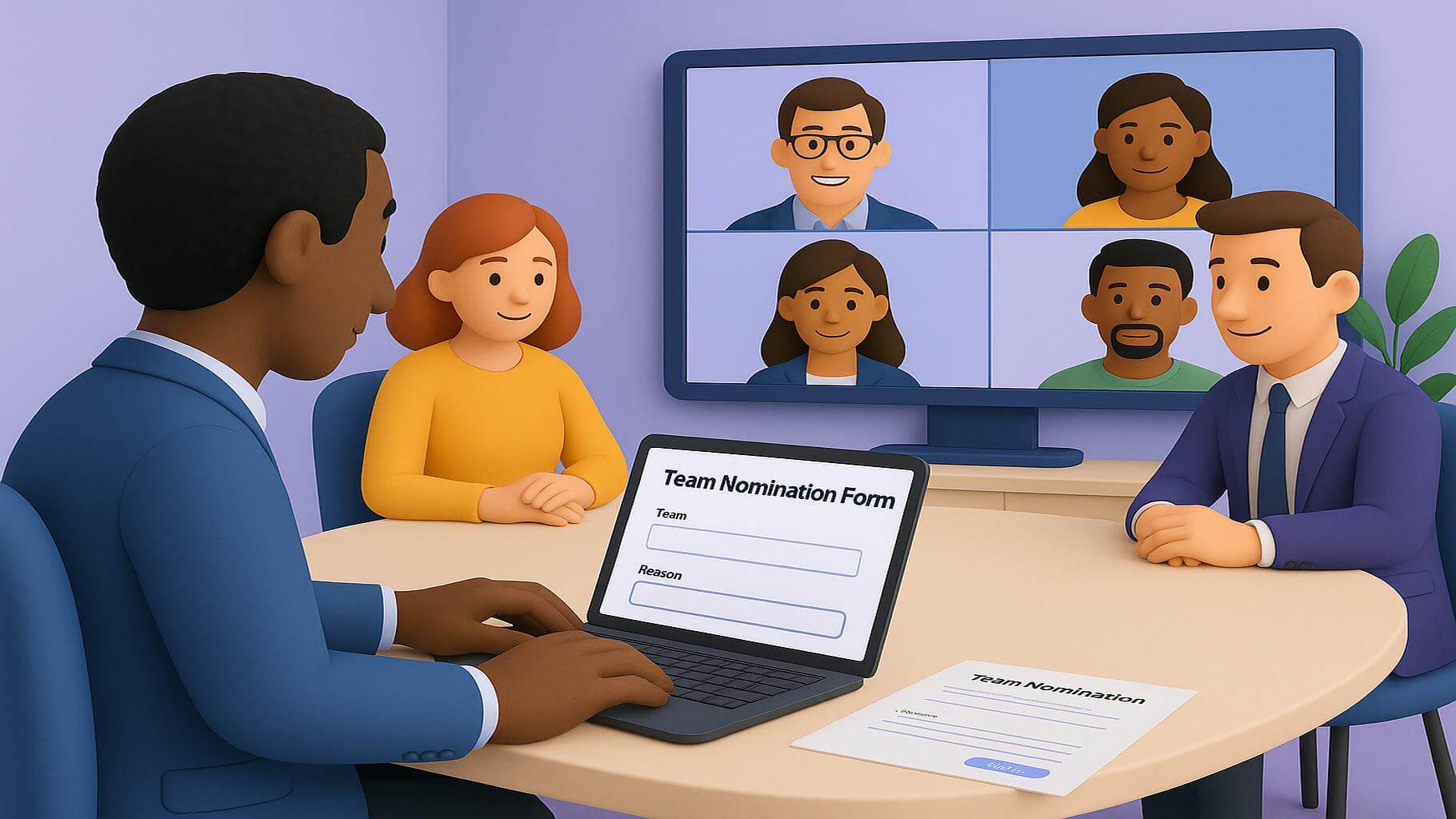
Team players who consistently demonstrate collaborative excellence often serve as catalysts for enhanced group performance while maintaining individual accountability and contributing to positive team culture. Effective team player nominations highlight specific collaborative behaviors that enhanced team effectiveness, document consistent supportive actions, and demonstrate how individual commitment to teamwork strengthened overall group outcomes through employee recognition and rewards. These nominations recognize employees who prioritized team success, maintained positive relationships, and demonstrated ongoing commitment to collaborative excellence in their daily work activities.
Cross-functional support team player nomination examples
Example 27: Inter-Department Collaboration Team Player
This team player consistently provided exceptional support to colleagues across multiple departments while maintaining excellence in individual responsibilities and demonstrating remarkable commitment to organizational success. She regularly volunteered to assist other teams during peak periods, shared expertise across departmental boundaries, and maintained positive relationships that enhanced cross-functional collaboration. The nominee's efforts resulted in improved communication between departments, enhanced project coordination, and stronger organizational cohesion that contributed to better business outcomes while maintaining individual productivity.
Example 28: Resource Sharing Excellence Team Player
A team player demonstrated exceptional commitment to resource sharing by coordinating equipment, information, and expertise across different teams while ensuring equitable access for all employees. She developed efficient systems for managing shared resources, maintained detailed records of resource utilization, and ensured that all teams received appropriate support for their project needs. The nominee's contributions led to improved resource efficiency, reduced operational costs, and enhanced collaborative effectiveness throughout the organization, while maintaining operational standards.
Peer assistance team player nomination examples
Example 29: Colleague Development Support Team Player
This team player consistently provided exceptional support to new employees while maintaining individual productivity and demonstrating remarkable commitment to colleague development and organizational success. She developed comprehensive onboarding assistance programs, provided ongoing mentoring support, and ensured that new team members received appropriate guidance for successful integration. The nominee's efforts resulted in faster employee adaptation, improved retention rates, and enhanced team performance through effective knowledge transfer and supportive colleague relationships, while maintaining high-quality training.
Example 30: Workload Balance Team Player
A team player demonstrated exceptional flexibility by consistently volunteering to assist colleagues with challenging tasks while maintaining individual performance standards and contributing to overall team success. She regularly identified opportunities to support overloaded team members, redistributed tasks fairly during busy periods, and maintained a positive attitude while adapting to changing work demands. The nominee's contributions led to improved team efficiency, reduced employee stress, and enhanced collaborative effectiveness during demanding project periods, while maintaining quality standards.
Positive attitude team player nomination examples
Example 31: Morale Enhancement Team Player
This team player consistently maintained an exceptional positive attitude while supporting colleagues through challenging periods and contributing to overall team morale and workplace satisfaction. She regularly encouraged and supported team members, celebrated colleagues' successes, and maintained an optimistic perspective even during difficult situations. The nominee's efforts led to improved team dynamics, an enhanced workplace culture, and stronger resilience during organizational challenges that required sustained collaborative effort and mutual support, while maintaining professional standards.
Example 32: Communication Excellence Team Player
A team player demonstrated exceptional communication skills by facilitating effective information sharing between team members while maintaining positive relationships and contributing to enhanced collaborative effectiveness. She regularly coordinated team communications, ensuring that all members received important updates and facilitating productive discussions during team meetings. The nominee's contributions led to improved information flow, reduced incidents of miscommunication, and enhanced decision-making processes, ultimately strengthening overall team performance while maintaining high-quality communication.
Team award nomination examples across different industries
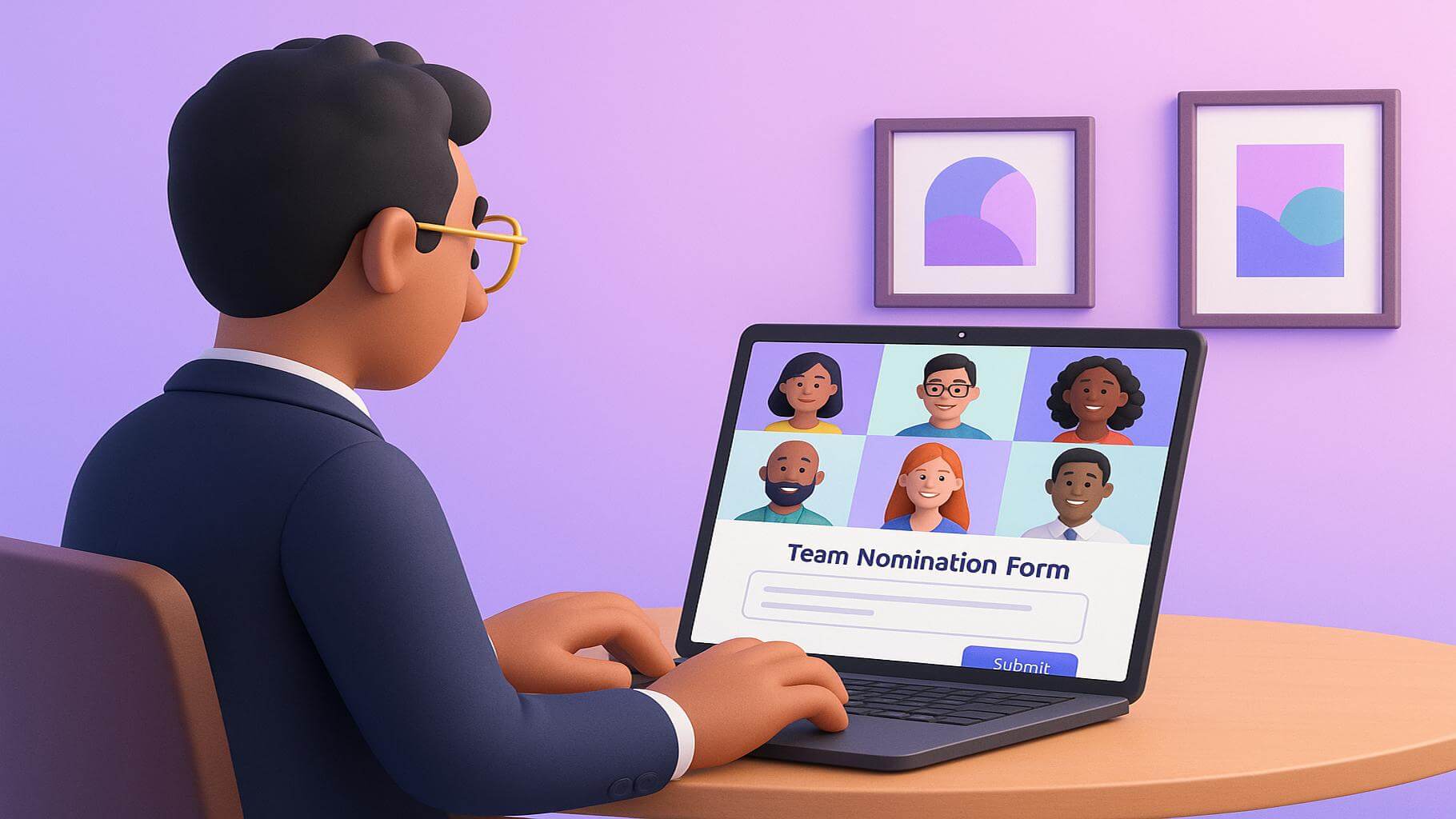
Different industries require specialized approaches to team recognition that acknowledge unique collaborative challenges, industry-specific achievements, and particular skill sets that contribute to sector-specific success. Effective industry-focused team award nomination examples demonstrate how collaborative excellence manifests within specific professional contexts while highlighting achievements that resonate with industry standards and expectations through workplace recognition programs. These nominations typically emphasize outcomes that reflect industry priorities, demonstrate sector-specific expertise, and showcase collaborative approaches that address unique challenges within particular professional environments.
Healthcare team nomination letter examples
Example 33: Patient Care Coordination Team
This healthcare team demonstrated exceptional collaborative excellence by coordinating comprehensive patient care services across multiple specialties while maintaining excellent communication with patients, families, and medical professionals. The group developed innovative approaches to care coordination, implemented efficient communication protocols, and ensured seamless transitions between different phases of treatment. Team members from nursing, social services, and administrative departments worked together to improve patient outcomes, reduce hospital readmission rates, and enhance overall patient satisfaction through coordinated care delivery while maintaining medical standards.
Example 34: Emergency Response Medical Team
A healthcare emergency response team demonstrated remarkable coordination during critical situations by implementing efficient triage procedures, maintaining excellent communication under pressure, and ensuring optimal patient care during high-stress medical emergencies. The group demonstrated exceptional teamwork in managing complex medical cases, coordinating with multiple departments, and maintaining positive patient relationships despite challenging circumstances. Team members consistently supported each other while providing excellent medical care that exceeded patient expectations and contributed to improved health outcomes while maintaining safety protocols.
Technology and software team nomination examples
Example 35: Software Development Innovation Team
This technology team demonstrated exceptional collaborative excellence by developing innovative software solutions that exceeded client requirements while maintaining rigorous quality standards and meeting aggressive development timelines. The group implemented effective project management processes, maintained excellent communication throughout the development cycles, and ensured comprehensive testing procedures, resulting in superior software products. Team members from the development, quality assurance, and project management departments collaborated effectively to deliver exceptional results that enhanced client satisfaction and strengthened the organizational reputation, while maintaining technical excellence.
Example 36: System Implementation Technical Team
A technology team demonstrated remarkable coordination during complex system implementations by managing multiple technical requirements, maintaining excellent communication with end-users, and ensuring minimal disruption to daily operations. The group developed comprehensive implementation strategies, provided exceptional technical support, and maintained positive relationships with employees, adapting to new systems. Team members consistently collaborated to resolve technical challenges, provide effective training, and ensure successful system adoption across multiple departments while maintaining operational continuity.
Sales and customer service team award nomination examples
Example 37: Client Relationship Management Team
This sales and customer service team achieved exceptional results by implementing comprehensive relationship management strategies that significantly enhanced customer satisfaction while exceeding sales targets and strengthening long-term business relationships.
The group demonstrated a remarkable commitment to understanding client needs, developing customized solutions, and maintaining ongoing communication, which resulted in increased customer loyalty. Team members collaborated effectively to share client insights, coordinate service delivery, and ensure consistent excellence in customer interactions, which contributed to substantial business growth and enhanced the organizational reputation while maintaining high service quality.
Nomination form examples for team recognition programs
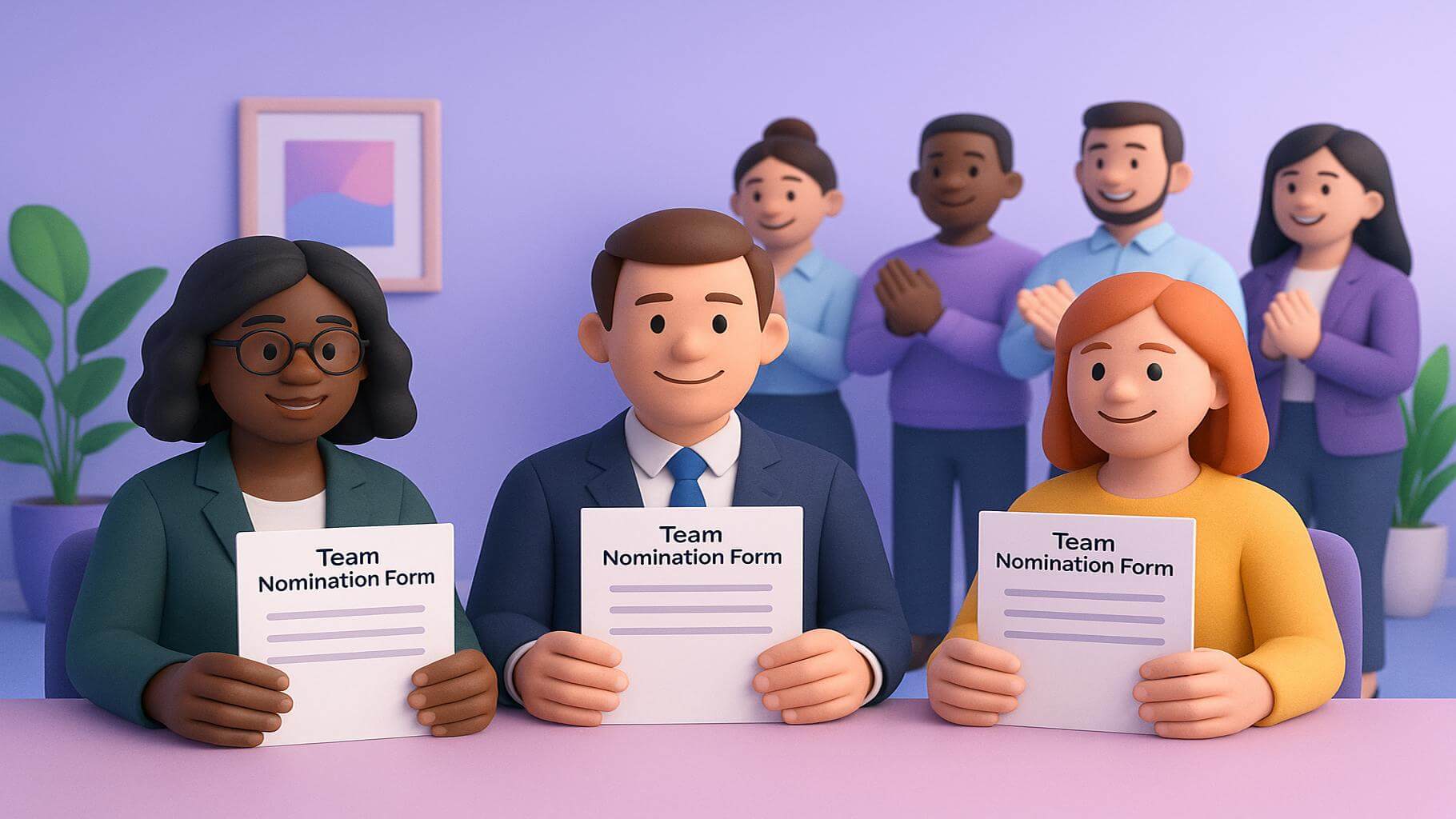
Effective nomination forms provide structured frameworks that guide nominators through comprehensive documentation processes while ensuring consistent information gathering and fair evaluation criteria. Well-designed team recognition nomination forms include specific sections for team identification, achievement documentation, impact assessment, and supporting evidence that helps evaluation committees make informed decisions through nomination form templates. These forms typically request detailed information about team composition, collaborative processes, measurable outcomes, and alignment with organizational values, facilitating a thorough evaluation of group achievements.
Structured team nomination form templates
Standard team nomination forms include essential sections for capturing comprehensive information about group achievements and collaborative excellence. The forms typically begin with identifying information, including the team name, department affiliations, team member names and positions, and brief descriptions of the team's purpose or project objectives. Additional sections request detailed achievement descriptions, specific outcome documentation, and evidence of collaborative excellence that demonstrates why the team merits recognition consideration.
The forms often include evaluation criteria sections that help nominators understand what information committees need for making fair recognition decisions. These criteria typically emphasize collaborative excellence, measurable outcomes, innovative approaches, alignment with organizational values, and evidence of exceptional teamwork that exceeds normal expectations. Clear criteria help ensure consistent evaluation across different nominations while providing guidance for nominators preparing comprehensive submissions.
Administrative sections of the forms request logistical information, including submission deadlines, contact information for follow-up questions, and signatures from appropriate supervisors or department heads. These sections help ensure that nominations receive proper authorization and that committees can contact nominators for additional details if needed during the evaluation process, particularly when additional consideration is required.
Group evaluation nomination form examples
Group evaluation forms emphasize collaborative processes and collective achievements rather than individual contributions within teams. These forms request specific information about how team members worked together, supported each other during challenges, and achieved results through coordinated efforts. The evaluation sections focus on group dynamics, shared decision-making processes, and evidence of mutual support that contributed to exceptional outcomes.
The forms typically include sections for describing team challenges and how groups overcame obstacles through collaborative problem-solving. Nominators explain how team members maintained positive working relationships, managed conflicts effectively, and supported each other during difficult periods. These sections help evaluation committees understand group resilience and collaborative effectiveness under challenging circumstances, while maintaining professional standards similar to those in employee award nomination examples.
Outcome documentation sections emphasize collective achievements and shared success rather than individual accomplishments. The forms request information about measurable group results, impact on organizational objectives, and evidence of team effectiveness that warrants recognition. This focus ensures that evaluations emphasize collaborative excellence and shared accountability for team success while maintaining evaluation integrity.
Multi-criteria team assessment nomination forms
Comprehensive assessment forms evaluate teams across multiple criteria, including collaboration effectiveness, innovation in approaches, impact on organizational objectives, and demonstration of company values. These forms provide detailed evaluation frameworks that help ensure fair comparison between different team nominations while capturing diverse aspects of team excellence. The multi-criteria approach recognizes that exceptional teams may excel in different areas while meeting various organizational needs and maintaining high standards of excellence.
The forms typically include weighted scoring sections that allow evaluation committees to assess teams across different performance dimensions. Common criteria include collaborative excellence, innovation and creativity, measurable outcomes, alignment with organizational values, and evidence of sustained high performance. The weighted approach helps ensure balanced evaluation that considers various types of team excellence while maintaining consistency across all nominations.
Supporting documentation sections request additional evidence, including project reports, performance metrics, client feedback, and other materials that substantiate nomination claims. These requirements help ensure that evaluations are based on comprehensive evidence rather than subjective impressions alone. The documentation approach promotes fairness and accuracy in recognition decisions while maintaining evaluation standards and ensuring thorough consideration of all relevant factors.
How Matter can help with team nominations
Matter transforms team recognition from complex nomination processes into simple, engaging experiences that happen naturally within your existing workflows. As a Slack-first and Teams-first recognition platform, Matter makes celebrating team achievements effortless while building stronger collaborative cultures through meaningful appreciation. The platform eliminates traditional barriers to team recognition by embedding appreciation directly into the communication tools teams use on a daily basis. This approach ensures that recognizing collaborative excellence becomes a natural part of workplace interactions rather than an additional administrative task.
Streamlined team recognition in Slack and Teams
Matter integrates directly into the communication tools your teams already use every day, making team nominations and recognition feel natural rather than burdensome. The platform transforms team appreciation into an ongoing conversation, rather than relying on formal administrative processes. Teams can instantly recognize collaborative achievements through customizable kudos cards that celebrate specific contributions and align with company values. This seamless integration means employees don't need to learn new systems or navigate complex interfaces to participate in team recognition programs.
Key benefits include:
- Instant team shout-outs directly in Slack or Teams channels
- Beautiful kudos cards that celebrate group achievements with customizable designs
- Simple setup process that takes just minutes to implement
- Free Forever plan that makes team recognition accessible to organizations of any size
Automated team celebration features
Matter's automation capabilities ensure that team milestones and achievements never go unnoticed while reducing administrative burden on managers and HR teams. The platform's Feedback Friday feature automatically prompts teams to share appreciation, creating consistent recognition habits without requiring manual oversight. These automated reminders help maintain momentum in recognition programs while ensuring that collaborative efforts receive regular acknowledgment. The system's intelligent automation adapts to team patterns and preferences, making recognition feel personal rather than mechanical.
Essential automation features:
- Feedback Friday reminders that encourage regular team appreciation
- Automated birthday and work anniversary celebrations for team members
- Weekly coin reset system that promotes authentic, ongoing recognition
- Milestone tracking that captures important team achievements automatically
Team recognition insights and analytics
Matter provides clear visibility into team recognition patterns while helping organizations understand the impact of collaborative appreciation on employee engagement and performance. The analytics dashboard reveals which teams are most active in recognizing each other and identifies collaboration trends across different departments. Organizations can utilize these insights to understand how recognition impacts team dynamics and the overall workplace culture. The platform's reporting features enable leaders to make informed decisions about recognition strategies, demonstrating the tangible value of team appreciation programs.
Analytics capabilities include:
- Recognition frequency tracking across different teams and departments
- Participation insights that identify highly collaborative groups
- Team engagement metrics that measure recognition program effectiveness
- Simple reporting dashboard that makes data actionable for program improvement
FAQs about team nominations
Q: What is a team nomination, and how does it differ from individual recognition?
A: A team nomination recognizes group achievements and collaborative excellence rather than individual performance. While individual recognition focuses on personal accomplishments, team nominations celebrate collective efforts, shared responsibility, and collaborative outcomes that result from coordinated teamwork.
Q: Who can submit team nominations in most organizations?
A: Typically, any employee can submit team nominations, including supervisors, colleagues, clients, or team members themselves. The nomination process usually requires identifying information about the nominator and may include approval from department supervisors before submission to evaluation committees.
Q: How are team nominations evaluated compared to employee of the month nominations?
A: Team nominations are evaluated based on collaborative excellence, group achievements, and collective impact rather than individual performance metrics. Evaluation committees assess how well teams worked together, supported each other, and achieved results through coordinated efforts rather than personal accomplishments.
Q: What criteria are typically used for team of the year nominations?
A: Team of the year nominations typically emphasize sustained excellence, long-term collaborative effectiveness, significant organizational impact, and consistent demonstration of company values throughout extended periods. These nominations require documentation of ongoing achievements and maintained performance standards.
Q: Can team member nominations be submitted for individuals within successful teams?
A: Yes, team member nominations recognize individual contributions within group contexts, highlighting how specific employees enhanced team effectiveness while maintaining collaborative focus. These nominations celebrate individuals who supported team success through exceptional collaborative behaviors.
Q: How often should team nomination programs run in organizations?
A: Most organizations run team nomination programs quarterly or annually, depending on project cycles and organizational objectives. Regular programs maintain recognition momentum while allowing sufficient time for teams to achieve meaningful accomplishments that warrant consideration.
Final thoughts about team nomination examples
Using these team nomination examples to recognize group achievements helps organizations build stronger collaborative cultures while celebrating the collective efforts that drive business success. Effective team nominations highlight collaborative excellence, document measurable group outcomes, and demonstrate how coordinated teamwork produces results that individual efforts alone cannot achieve. By implementing comprehensive team recognition programs, companies can reinforce collaborative values, inspire continued teamwork, and ensure that group achievements receive appropriate acknowledgment alongside individual accomplishments.
Benefits of implementing team award nomination example programs
Team recognition programs create positive organizational cultures that value collaboration, shared responsibility, and collective achievement. These programs help employees understand that teamwork is essential for organizational success while providing concrete examples of what excellent collaboration looks like in practice through employee recognition programs. Regular team recognition encourages continued collaborative behavior, strengthens workplace relationships, and promotes positive team dynamics that enhance overall organizational performance and employee satisfaction.
The structured approach to team recognition ensures fair evaluation of group achievements while providing comprehensive documentation of collaborative excellence that can guide future team development initiatives. Organizations benefit from improved employee engagement, enhanced collaboration skills, and stronger team cohesion that translates into better business outcomes, increased productivity, and sustained competitive advantages in their respective markets and industries through strategic recognition and rewards.
Ready to take your team recognition strategy to the next level? Schedule a demo with a Matter expert today and discover how the right tools can help you recognize great teamwork, boost collaborative engagement, and support long-term organizational success.






















